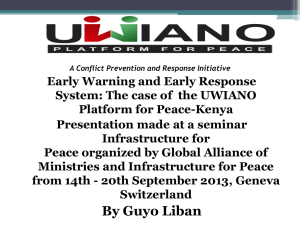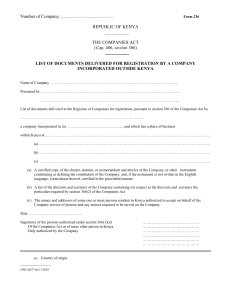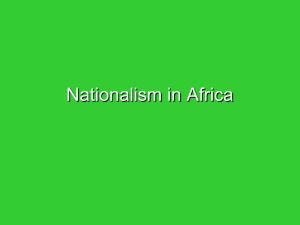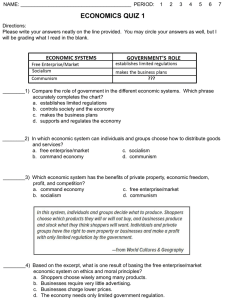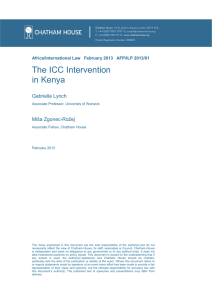Situation in Kenya
advertisement
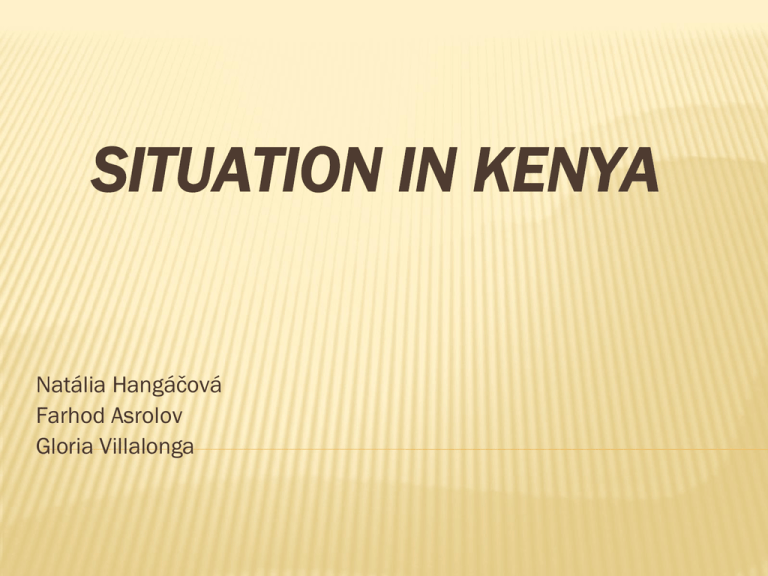
SITUATION IN KENYA Natália Hangáčová Farhod Asrolov Gloria Villalonga REPUBLIC OF KENYA Location: East African country which borders Ethiopia to the North, Somalia to the East, Tanzania to Population: The land area is 580,000 km2 and it has a population of 39 million people from many Name: The country's name is due to Mount Kenya, the second highest mountain in Africa. Distribution: Kenya has 47 districts, each with a semi-autonomous government on the central Multiparty republic Religion 1963: Independence the South, Uganda to the West and Sudan South Northwest. cultures and backgrounds. government in Nairobi. WHAT HAPPENED AND WHEN? • Post-election violence • 2007-2008 Kenya crisis was followed with presidential elections (27.12.2007) • Electoral fraud occurred THE CRUX OF THE PROBLEM WAS: • President Mwai Kibaki was re-elected into the function and people rejected the results of elections • There were 6 suspects called - Ocampo six • Pre-trial chamber confirmed charges against Kenyatta, Ruto and Sang • Pre-trial chamber declined to confirm charges against Ali, Kosgey and Muthaura • Kenyatta was released because of lack of evidence required for the trial to begin • That is why on ICC webpage there are only 2 names stated • RUTO • SANG BACK TO ELECTIONS: • Pre-election survey • Leading candidates • The President - Mwai Kibaki • Party of National Unity • Raila Odinga • Orange Democratic Movement • Indications showed that Odinga was likely to win the elections.. • ..However.. • According to results of Electoral Commission of Kenya: • Kibaki won the election, was re-elected and became President After the Electoral Commission's announcement Odinga rejected the results because of the obvious electoral fraud This was the beginning of the violence … Violence was mainly perpetrated along tribals: Kibaki (President) was part of the Kikuyu tribe,(largest) whereas Odinga was part of Luo tribe • During the post-election violence: • 1,200 people died and more than 500,000 were displaced from their homes • A peace was agreed between Kibaki and Odinga by mediation made by former United Nations SecretaryGeneral : Kofi Annan • The deal was as follows: • Kibaki will remain President • Odinga will take an office of the Prime Minister (which was newly created) FOR THE FIRST TIME • The International Criminal Court's prosecutor may open a formal investigation in one of 3 circumstances: • when a situation is referred by the State party or a State which is not a party to the Rome Statute, if concerning crimes committed within the states territory or by one of it’s nationals • when the situation is referred to ICC by the UN Security Council • under his own volition with authorisation from a PreTrial Chamber INTERNATIONAL CRIMINAL COURT DOCUMENT CALLED UNDERSTANDING INTERNATIONAL CRIMINAL COURT Article 15 Prosecutor: 1. The Prosecutor may initiate investigations proprio motu on the basis of information on crimes within the jurisdiction of the Court. Statute of International Criminal Court Proprio motu • 6. November 2009 The ICC Presidency assigned the situation in Kenya to PreTrial Chamber • 26. November The prosecutor made an application for authorisation to open a formal investigation • 31. March 2010 Pre-trial chamber granted authorisation • The judges of Pre-trial chamber: Trendafilova, Kaul and Tarfusser noted: …Article 15 of the Rome Statute allows the Prosecutor to investigate upon his own volition, but this case was for the first time Prosecutor decided investigate manner on his own volition… DIFFERENT OPINION • Judge Kaul had a different opinion • judgment was passed by a 2–1 majority • In his opinion he wrote: In essence, the main reason for this position is the following: “..both, my interpretation of article 7(2) (a) of the [Rome] Statute, which sets out the legal definition of "attack directed against any civilian population" as constitutive contextual element of crimes against humanity, and my examination of the Prosecutor's Request and supporting material, including the victims' representations, have led me to conclude that the acts which occurred on the territory of the Republic of Kenya do not qualify as crimes against humanity falling under the jurisdictional ambit of the Court.” BACKGROUND ON THE TRIALS BEFORE THE ICC On 8 March 2013, the ICC announced that the trial of Uhuru Kenyatta would commence on 9 July 2013 and that the trial for Ruto and Sang would begin in late-May of 2013. These trial dates were further delayed that the proceedings for Ruto and Sang would be pushed back to 10 September 2013. The Court announced on 20 June 2013 that the trial of Kenyatta would be pushed back to 12 November 2013. Ruto , Sang and Kenyatta filed motions against the requirement to participate in proceedings in person at The Hague. On 18 June, the judges granted Ruto permission to participate inabsentia for the trial and advised that it be partially held in Tanzania and Kenya; however, Chief Prosecutor Fatou Bensouda appealed this decision on 24 June 2013. On 2 May 2013, Kenya’s UN ambassador sent an official letter to the Security Council calling for the UNSC to not only defer the case, but to terminate it altogether, arguing that it posed a threat to international peace and security. UNSC is able to defer ICC cases for up to 12 months in accordance with Article 16 of the Rome Statute, the UNSC does not have the authority to terminate cases on behalf of the Court. Confirmation of Charges Hearings The hearing in the case of Ruto and Sang took place in The Hague between 1 and 8 September 2011. William Ruto The prosecutor claims that the defendant formed an organization with other Kalenjin people as early as 2006 with the stated purpose of removing members of the Kikuyu, Kamba and Kisii ethnic groups from the Rift Valley region of Kenya to create a large pro-ODM power base in that region. To force these communities to relocate, the group planned to inflict fear and destroy homes and property until the victims left the region. 15 April 2007 a ceremony took place at a milk plant in Molo where members of the network swore an oath of allegiance. Next meeting took place on 22 December 2007 at Ruto's house and that guns and money were distributed to the each participants. NETWORK MEMBERS 1) TRIBAL ELDERS 3) MEDIA 2) POLITICAL 4) MILITARY 5) FINANCIAL Joshua Arap Sang At the time of the election he was the presenter of a radio programe on the Kalenjin language station KASS FM was accused of using his broadcasts to spread the implementation of the common plan by: placing his show at the disposal of the organization, fanning violence by spreading hate messages and broadcasting false news regarding alleged murder of Kalenjin people in order to inflame the violent atmosphere. Kenyatta He was the mediator between the Party of National Unity (PNU) and the Mungiki and organized a series of meetings from November 2007 , other government officials, businessmen and Mungiki leaders. Kenyatta was accused of providing funding, uniforms and weapons to Mungiki and pro-PNU youth to carry out their attacks. CONFIRMATION OF CHARGES The outcomes of the confirmation of charges hearings were announced on 23 January 2012. Despite the ICC regulations requiring the Pre-Trial Chamber to normally issue a verdict on confirmation of charges within sixty days of the hearings taking place The chamber issued a ruling on 26 October 2011 to vary this time limit to allow both the results in both cases to be announced simultaneously. The chamber ruled by majority to confirm all of the charges against William Ruto and Joshua Arap Sang, to confirm all of the charges with the exception of "other forms of sexual violence" against Uhuru Kenyatta PERPETRATORS https://www.youtube.com/watch?v=7PIZ1q0ttqM 2013: Two court rooms of the ICC were created. The President assigned the case Ruto/Sang to Trial Chamber V (a) and Kenyatta case to the Trial Chamber V (b). In 2013 , Kenya is divided into 47 counties. 2012-2014: Actions of Islamist militias in the North were increased supported from Somalia, among others by the Al-Shabaab militia in protest against the Kenyan intervention in Somalia. The most serious incident was the bloodiest assault on Westgate mall affect the capital Nairobi on September 22, 2013. 2014: Kenyan security forces conducted several abusive counterterrorism operations in Nairobi, on the coast, and in North Eastern region following attacks and intercommunal clashes. The operations largely targeted ethnic Somali and Muslim communities. 2010 CONSTITUTION 2010 Constitution of Kenya, currently in force, replaced the 1969 Constitution. The new Constitution was approved by 67% of Kenyan voters. The key changes proposed by the new constitution: - Separation of Powers between the three arms of government: - The Executive: who holds executive authority and the qualifications. - The Legislature: the composition, and representation of the people. An introduction of an upper house, the Senate. - The Judiciary: qualifications to hold office and appointment. - Only two levels of Government: National and Counties. - Citizenship: among other issues, gender discrimination was ended, and citizens who acquire foreign citizenship will not lose their Kenyan citizenship. SOMALIA AND KENYA Relations between Kenya and Somalia have never been very good. In fact, their enmity was hatched as in colonial times, due to the interests of Europeans in the area. Kenya's problems continued to worsen, especially, following the emergence of the terrorist group Al-Shabab (Mujahideen Youth Movement) in 2007, whose main objective is to impose an Islamic state in the Horn of Africa. Al Shabab is an extremist group that has been linked to Al Qaeda. It is based in Somalia and is listed as a terrorist group by the United States since 2008 . AL-SHABAB Aim: To turn Somalia into an ally of the Islamic State and take complete control to expand throughout Africa and beyond Mission: To kill all those who profess a different religion. 2nd April 2015: in Kenya, the group attempted at a university, leaving a total of 152 dead people , plus 4 of the terrorists who participated in the slaughter . Muslims were released and Christians were assassinated by gunshots and decapitation. It is the largest Islamist attack in Kenya. The international community is responding with a UN mission, led by the United States, the Restore Hope operation , which was a failure, after the killing of several American soldiers , it was a shock to the American public. HUMAN RIGHTS About membership in the seven bodies of the International Bill of Human Rights , including the Human Rights Committee, Kenya has signed or ratified :

